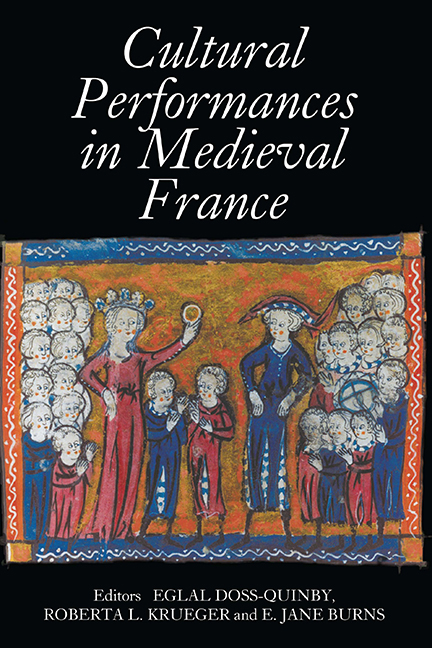19 results
27 - Notre Dame
- from Volume II
-
-
- Book:
- The Cambridge History of Medieval Music
- Published online:
- 04 August 2018
- Print publication:
- 09 August 2018, pp 834-880
-
- Chapter
- Export citation
Frontmatter
-
- Book:
- Cultural Performances in Medieval France
- Published by:
- Boydell & Brewer
- Published online:
- 24 October 2017
- Print publication:
- 15 March 2007, pp i-vi
-
- Chapter
- Export citation
Contributors
-
- Book:
- Cultural Performances in Medieval France
- Published by:
- Boydell & Brewer
- Published online:
- 24 October 2017
- Print publication:
- 15 March 2007, pp xiii-xiv
-
- Chapter
- Export citation
PART I - POETIC AND MUSICAL PERFORMANCES
-
- Book:
- Cultural Performances in Medieval France
- Published by:
- Boydell & Brewer
- Published online:
- 24 October 2017
- Print publication:
- 15 March 2007, pp 1-2
-
- Chapter
- Export citation
PART V - RE–ENACTMENTS AND LEGACIES
-
- Book:
- Cultural Performances in Medieval France
- Published by:
- Boydell & Brewer
- Published online:
- 24 October 2017
- Print publication:
- 15 March 2007, pp 233-234
-
- Chapter
- Export citation
PART IV - PERSUASIVE PERFORMANCES
-
- Book:
- Cultural Performances in Medieval France
- Published by:
- Boydell & Brewer
- Published online:
- 24 October 2017
- Print publication:
- 15 March 2007, pp 179-180
-
- Chapter
- Export citation

Cultural Performances in Medieval France
- Essays in Honor of Nancy Freeman Regalado
-
- Published by:
- Boydell & Brewer
- Published online:
- 24 October 2017
- Print publication:
- 15 March 2007
Contents
-
- Book:
- Cultural Performances in Medieval France
- Published by:
- Boydell & Brewer
- Published online:
- 24 October 2017
- Print publication:
- 15 March 2007, pp vii-x
-
- Chapter
- Export citation
PART II - PERFORMING SEXUAL AND SOCIAL IDENTITIES
-
- Book:
- Cultural Performances in Medieval France
- Published by:
- Boydell & Brewer
- Published online:
- 24 October 2017
- Print publication:
- 15 March 2007, pp 55-56
-
- Chapter
- Export citation
List of Illustrations
-
- Book:
- Cultural Performances in Medieval France
- Published by:
- Boydell & Brewer
- Published online:
- 24 October 2017
- Print publication:
- 15 March 2007, pp xi-xii
-
- Chapter
- Export citation
Subtilitas and Delectatio: Ne m'a pas oublié
- from PART I - POETIC AND MUSICAL PERFORMANCES
-
-
- Book:
- Cultural Performances in Medieval France
- Published by:
- Boydell & Brewer
- Published online:
- 24 October 2017
- Print publication:
- 15 March 2007, pp 25-44
-
- Chapter
- Export citation
Tabula Gratulatoria
-
- Book:
- Cultural Performances in Medieval France
- Published by:
- Boydell & Brewer
- Published online:
- 24 October 2017
- Print publication:
- 15 March 2007, pp 301-302
-
- Chapter
- Export citation
Nancy Freeman Regalado, Curriculum Vitae
-
- Book:
- Cultural Performances in Medieval France
- Published by:
- Boydell & Brewer
- Published online:
- 24 October 2017
- Print publication:
- 15 March 2007, pp xxiii-xxxvi
-
- Chapter
- Export citation
PART III - DEVOTIONAL PRACTICE AND TEXTUAL PERFORMANCE
-
- Book:
- Cultural Performances in Medieval France
- Published by:
- Boydell & Brewer
- Published online:
- 24 October 2017
- Print publication:
- 15 March 2007, pp 121-122
-
- Chapter
- Export citation
Tabula Gratulatoria
-
- Book:
- Cultural Performances in Medieval France
- Published by:
- Boydell & Brewer
- Published online:
- 24 October 2017
- Print publication:
- 15 March 2007, pp 303-304
-
- Chapter
- Export citation
LABOURING IN THE MIDST OF WOLVES: READING A GROUP OF FAUVEL MOTETS
-
- Journal:
- Early Music History / Volume 22 / August 2003
- Published online by Cambridge University Press:
- 01 September 2003, pp. 169-245
- Print publication:
- August 2003
-
- Article
- Export citation
WHO ‘MADE’ THE MAGNUS LIBER?
-
- Journal:
- Early Music History / Volume 20 / September 2001
- Published online by Cambridge University Press:
- 24 October 2001, pp. 227-266
- Print publication:
- September 2001
-
- Article
- Export citation
Hans Tischler, ed., The Earliest Motets (to circa 1270): a Complete Comparative Edition. 3 vols., New Haven and London, Yale University Press, 1982. xx + 1609 pp. viii + 248 pp.
-
- Journal:
- Early Music History / Volume 4 / October 1984
- Published online by Cambridge University Press:
- 05 December 2008, pp. 362-375
- Print publication:
- October 1984
-
- Article
- Export citation
Johannes de Garlandia on organum in speciali*
-
- Journal:
- Early Music History / Volume 2 / October 1982
- Published online by Cambridge University Press:
- 05 December 2008, pp. 129-160
- Print publication:
- October 1982
-
- Article
- Export citation



